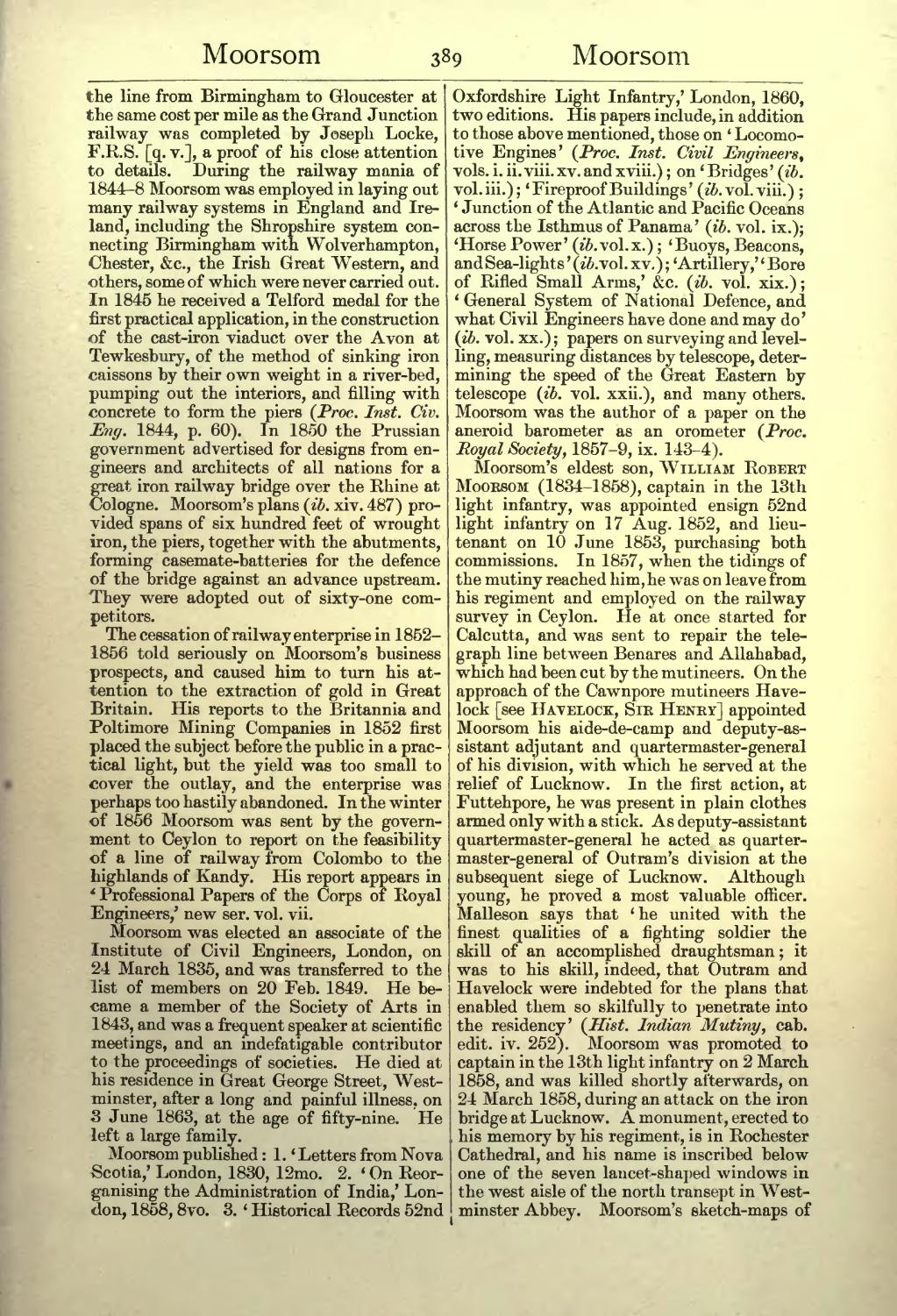the line from Birmingham to Gloucester at the same cost per mile as the Grand Junction railway was completed by Joseph Locke, F.R.S. [q. v.], a proof of his close attention to details. During the railway mania of 1844-8 Moorsom was employed in laying out many railway systems in England and Ireland, including the Shropshire system connecting Birmingham with Wolverhampton, Chester, &c., the Irish Great Western, and others, some of which were never carried out. In 1845 he received a Telford medal for the first practical application, in the construction of the cast-iron viaduct over the Avon at Tewkesbury, of the method of sinking iron caissons by their own weight in a river-bed, pumping out the interiors, and filling with concrete to form the piers (Proc. Inst. Civ. Eng. 1844, p. 60). In 1850 the Prussian government advertised for designs from engineers and architects of all nations for a great iron railway bridge over the Rhine at Cologne. Moorsom's plans (ib. xiv. 487) provided spans of six hundred feet of wrought iron, the piers, together with the abutments, forming casemate-batteries for the defence of the bridge against an advance upstream. They were adopted out of sixty-one competitors.
The cessation of railway enterprise in 1852-1856 told seriously on 'Moorsom's business prospects, and caused him to turn his attention to the extraction of gold in Great Britain. His reports to the Britannia and Poltimore Mining Companies in 1852 first placed the subject before the public in a practical light, but the yield was too small to cover the outlay, and the enterprise was perhaps too hastily abandoned. In the winter of 1856 Moorsom was sent by the government to Ceylon to report on the feasibility of a line of railway from Colombo to the highlands of Kandy. His report appears in 'Professional Papers of the Corps of Royal Engineers,' new ser. vol. vii.
Moorsom was elected an associate of the Institute of Civil Engineers, London, on 24 March 1835, and was transferred to the list of members on 20 Feb. 1849. He became a member of the Society of Arts in 1843, and was a frequent speaker at scientific meetings, and an indefatigable contributor to the proceedings of societies. He died at his residence in Great George Street, Westminster, after a long and painful illness, on 3 June 1863, at the age of fifty-nine. 'He left a large family.
Moorsom published : 1. 'Letters from Nova Scotia,' London, 1830, 12mo. 2. 'On Reorganising the Administration of India,' London, 1858, 8vo. 3. 'Historical Records 52nd Oxfordshire Light Infantry,' London, 1860, two editions. His papers include, in addition to those above mentioned, those on 'Locomotive Engines' (Proc. Inst. Civil Engineers, vols. i. ii. viii. xv. and xviii.) ; on i Bridges ' (ib. vol.iii.); 'Fireproof Buildings' (ib. vol. viii.) ; 'Junction of the Atlantic and Pacific Oceans across the Isthmus of Panama' (ib. vol. ix.); 'Horse Power' (z'i.vol.x.) ; 'Buoys, Beacons, and Sea-lights ' ft&.vol. xv,) ; 'Artillery,' 'Bore of Rifled Small Arms,' &c. (ib. vol. xix.) ; ' General System of National Defence, and what Civil Engineers have done and may do' (ib. vol. xx.) ; papers on surveying and levelling, measuring distances by telescope, determining the speed of the Great Eastern by telescope (ib. vol. xxii.), and many others. Moorsom was the author of a paper on the aneroid barometer as an orometer (Proc. Royal Society, 1857-9, ix. 143-4).
Moorsom's eldest son, William Robert Moorsom (1834-1858), captain in the 13th light infantry, was appointed ensign 52nd light infantry on 17 Aug. 1852, and lieutenant on 10 June 1853, purchasing both commissions. In 1857, when the tidings of the mutiny reached him, he was on leave from his regiment and employed on the railway survey in Ceylon. He at once started for Calcutta, and was sent to repair the telegraph line between Benares and Allahabad, which had been cut by the mutineers. On the approach of the Cawnpore mutineers Havelock [see Havelock, Sir Henry] appointed Moorsom his aide-de-camp and deputy-assistant adjutant and quartermaster-general of his division, with which he served at the relief of Lucknow. In the first action, at Futtehpore, he was present in plain clothes armed only with a stick. As deputy-assistant quartermaster-general he acted as quartermaster-general of Outram's division at the subsequent siege of Lucknow. Although young, he proved a most valuable officer. Malleson says that 'he united with the finest qualities of a fighting soldier the skill of an accomplished draughtsman ; it was to his skill, indeed, that Outram and Havelock were indebted for the plans that enabled them so skilfully to penetrate into the residency' (Hist. Indian Mutiny, cab. edit. iv. 252). Moorsom was promoted to captain in the 13th light infantry on 2 March 1858, and was killed shortly afterwards, on 24 March 1858, during an attack on the iron bridge at Lucknow. A monument, erected to his memory by his regiment, is in Rochester Cathedral, and his name is inscribed below one of the seven lancet-shaped windows in the west aisle of the north transept in Westminster Abbey. Moorsom's sketch-maps of
